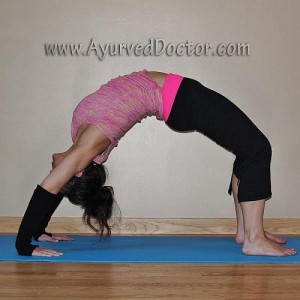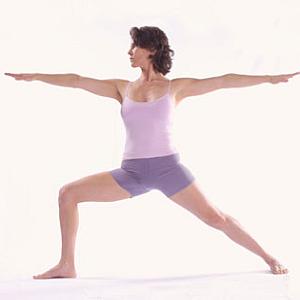Vriksasana is termed as tree pose, since Vriksa in Sanskrit means tree. The Buddha commented once that dualities in life, such as gain or loss, pleasure or sorrow, and praise or blame will come and go in our lives like strong winds, but we should remain like a giant tree and stand firm in the midst of such winds. Vriksasana is meant to bring balance in our body and it is one of the initial asanas that should be practiced before a yoga student ventures into other asanas. Many yoga practitioners also use Vriksasana to bring themselves into normal focus after doing the other intense standing postures or asanas.
Balance of ease and effort is the most important factor in Vriksasana. If you try to hold yourself very tight in Vriksasana, the pose will become rigid and you will find it difficult to balance yourself. Further, tension will creep in both your body and mind. If you are too easy in this position, you will not be able to hold the pose, the lifted foot will slip, the supporting leg will tire quickly and the lower back area will undergo more strain when the chest slump. Hence, ideally you should energize yourself enough to hold proper alignment, while remaining soft enough so that the body stays balanced and the mind is able to focus and relax.
Procedure for Vriksasana
You can proceed to Vriksasana from Tadasana. You should shift weight onto one leg, say the left leg, with the entire sole of the left foot remaining in full contact with the ground. You should now bend the right knee and place the right foot on your inner thigh, like in a half lotus position, inhaling slowly when you move the right leg. In the initial stages, you can use your hands to place your right foot on the left inner thigh. The toes of the right foot should point directly downwards. The left foot, the center of your pelvis, the shoulders and your head should remain firm in a vertical alignment. You can raise your hands above the head along the ears with or without clasping them together or you can clasp your hands in front of your chest like the worshipping or Anjali Mudra. You can remain in this position between 20 seconds and 60 seconds. You can then return to standing pose or Tadasana while slowly exhaling. You can repeat this Vriksasana on the other leg.
Benefits of Vriksasana
Vriksasana improves body balance, poise, posture and concentration. It further increases the range of possible motion in your hip, deepens your thorax, strengthens your ankles, and tones up the muscles in your legs, chest and back. Vriksasana also strengthens your calves, thighs and spine. It stretches the inner thighs, groins, shoulders and chest. Vriksasana reduce flat feet and relieves sciatica.
Precautions and Contraindications
If you are suffering from high blood pressure, you may face some risk if you raise your hands above your head. Such persons can hold the hands clasped at chest level in Anjali mudra. People suffering from low blood pressure, insomnia or headache should avoid this asana. You should avoid leaning towards one side, rotating or bending the knee that is supporting your body outward, pushing one hip outwards, losing concentration and looking downwards.












